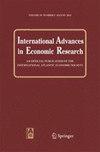Competition and Stability in the European Union Banking Sector
IF 0.7
Q3 ECONOMICS
引用次数: 0
Abstract
Abstract This paper empirically tests the two competing hypotheses regarding the relationship between competition and stability: the competition-fragility hypothesis and the competition-stability hypothesis. The banking sector stability is proxied with the estimated Z-score, which provides a measure of overall bank stability. Two different measures are used to represent bank competition: the Herfindahl–Hirschman Index (a specific measure of market concentration) and the Boone indicator (which measures competition from an efficiency perspective). Using data from the Moody’s Analytics BankFocus database and the World Bank Global Financial Development database, the paper applies panel estimations to a relatively large panel, including 784 relevant banks from all 27 European Union countries, between 2006 and 2021. The main findings overall confirm the validity of the competition-fragility hypothesis. Moreover, the results obtained for two specific European Union countries, Germany and France, highlight some specific differences, particularly regarding the effects of bank market concentration and the responses to the crises that affected the European Union banking institutions over the considered period. The findings of this paper reinforce the relevance of the policy maker’s role and indicate, for example, that bank market competition in the European Union is probably already sufficiently high and should not be reinforced, as overall, the increase in bank competition seems detrimental to the stability of European Union banking institutions.欧盟银行业的竞争与稳定
摘要本文实证检验了关于竞争与稳定关系的两个相互竞争的假说:竞争-脆弱性假说和竞争-稳定性假说。银行部门的稳定性用估计的z分数来表示,z分数提供了整体银行稳定性的衡量标准。两种不同的指标被用来代表银行竞争:赫芬达尔-赫希曼指数(一种衡量市场集中度的具体指标)和布恩指标(从效率角度衡量竞争)。本文利用穆迪分析银行焦点数据库和世界银行全球金融发展数据库的数据,将小组估计应用于一个相对较大的小组,包括2006年至2021年间来自所有27个欧盟国家的784家相关银行。主要研究结果总体上证实了竞争-脆弱性假说的有效性。此外,对两个特定的欧盟国家,德国和法国所获得的结果,突出了一些具体的差异,特别是关于银行市场集中度的影响和对所考虑的时期内影响欧盟银行机构的危机的反应。本文的研究结果强化了政策制定者角色的相关性,并指出,例如,欧盟的银行市场竞争可能已经足够高,不应该再加强,因为总体而言,银行竞争的增加似乎不利于欧盟银行机构的稳定。
本文章由计算机程序翻译,如有差异,请以英文原文为准。
求助全文
约1分钟内获得全文
求助全文
来源期刊

International Advances in Economic Research
ECONOMICS-
CiteScore
1.50
自引率
8.30%
发文量
19
期刊介绍:
International Advances in Economic Research (IAER) was established to promote the dissemination of economic and financial research within the international community. Founded in 1995 by the International Atlantic Economic Society, a need was identified to provide the latest research on today''s economic policies and tomorrow''s economic and financial conditions. Economists can no longer be concerned with professional developments only in their home country. Research by scholars in one country can easily have implications for other countries, yet often vital results are not shared. Economic restructuring in a shrinking world demands close analysis and careful interpretation. In IAER, authors from around the globe look at these issues, coming together in the cross-fertilization of multinational ideas. The journal provides economists, financial specialists, and scholars in related disciplines with much-needed opportunities to share their insights with worldwide colleagues. Policy-oriented, empirical, and theoretical research papers in all economic and financial areas are welcome, without regard to methodological preferences or school of thought. All manuscripts are submitted to a double-blind, peer review process.
In addition to formal publication of full-length articles, IAER provides an opportunity for less formal communication through its Research Notes section. A small point may not be worthy of a full-length, formal paper but is important enough to warrant dissemination to other researchers. Research in progress may be of interest to other scholars in the field. A research approach ending in negative results needs to be shared to save others similar pitfalls. Research Notes has been established to facilitate this form of communication. The section provides a means by which short manuscripts of less than 200 words can quickly appear in IAER. The review process for these shorter manu scripts is usually completed within 30 days.
Officially cited as: Int Adv Econ Res
 求助内容:
求助内容: 应助结果提醒方式:
应助结果提醒方式:


